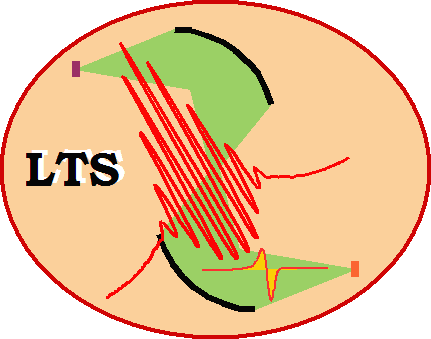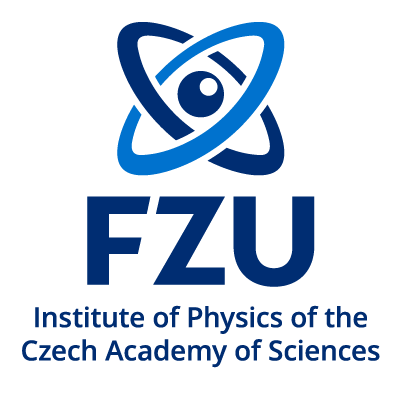Research – ferroelectric materials
Introduction
Time-domain THz transmission spectroscopy (TDTTS) constitutes a bridge between the “classical” (or Fourier transform) infrared spectroscopy (FTIR) and the microwave monochromatic spectroscopy. For many compounds, this spectral range contains information about the behaviour of low-frequency (soft) polar phonons and relaxation mechanisms (so called central modes) which determine the low-frequency dielectric behavior of the material and which are often responsible for structural (namely ferroelectric) phase transitions.
The electrical control of the propagation of terahertz radiation is of high importance in the current THz technology and has received recently a considerable attention. Ferroelectric materials are suitable for the modulation of the permittivity by applied bias or temperature. Thin film structures based on SrTiO3 and/or (Ba,Sr)TiO3 exhibit a big potential for applications in tunable devices in the GHz and THz spectral range.
Our major achievements
- Characterization of microwave ceramics (BiZN, CaTiO3, A5B4O15) [1–11]
- Soft mode behaviour in BaTiO3, SrTiO3 and KTaO3 [12–20].
- Tunability of unstrained and strained SrTiO3 thin films and heterostructures [21–27].
- Soft mode and central mode behaviour in ferroelectrics with Aurivilius structure [28–30]
- Design of tunable photonic structures based on ferroelectric materials
Tunable perovskite ferroelectrics
Displacive ferroelectrics are characterized by the existence of a strong polar soft lattice vibrational mode responsible for the ferroelectric phase transition. Single crystals of barium titanate (BaTiO3, BTO) exhibit typical behavior of a displacive ferroelectric material, which means that the dielectric behavior of BTO close to the ferroelectric phase transition is fully controlled by the soft mode dynamics which slows down close to the transition temperature. In strontium titanate (SrTiO3, STO) a strong soft mode is also observed, which exhibits a frequency decrease (softening) upon cooling; however, the compound remains paraelectric down to 0 K due to quantum fluctuations. The contribution of the soft mode to the low-frequency dielectric permittivity is very high in these ferroelectric perovskite compounds, owing to its strongly polar character and very low frequency:
| Δε = f/ω02, | (1) |
where f is the oscillator strength proportional to the square of the effective charge associated with the soft mode eigenvector and ω0 is the soft mode frequency. The electric-field (E) tunability of the dielectric function is related to the strongly anharmonic character of the soft mode leading to ω0(E) dependence. The elementary cell along with the eigenvector of the soft mode for the ferroelectric perovskite compounds in shown in Fig. 1.
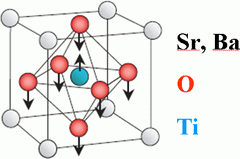
Fig. 1.
Elementary cell of (Ba,Sr)TiO3. The arrows indicate schematically the eigenvector of the soft mode.
Significant differences are often observed between (Ba, Sr)TiO3 bulk single crystals and thin films. The permittivity of the thin films is somewhat lower than in single crystals and the losses are frequently higher. Due to the high dielectric strength of the soft mode in these compounds the sensitivity of TDTTS measurements is sufficient for the characterization of the films with thicknesses below 1 µm.
It has been shown recently that the strain is one of the important factors affecting the ferroelectric properties of STO because of its strong coupling to the polarization. It is possible to prepare epitaxial thin STO films on different substrates with the aim to finely tune the lattice mismatch between STO and the substrate material and the strain within the film. For STO films grown on a DyScO3 (DSO) substrate the particular value of the lattice parameters mismatch (~ 1 %) induces a tensile strain which shifts the ferroelectric transition close to the room temperature. The actual values of the temperature and strain define the working point for the field-induced tuning of the low-frequency dielectric properties of STO which may then find applications e.g. in THz modulators, tunable photonic crystals or metamaterials.
We have investigated various kinds of strained multilayers with several thicknesses of STO layers (10, 50 and 100 nm) which may exhibit a different degree of structural relaxation and, consequently, a different strain. The scheme depicting the sample and THz beam geometry is shown in Fig. 2. A tensile strain develops in the STO films and, at zero field, it shifts the eigenfrequency of the ferroelectric soft mode down by ~25 – 45 cm−1 with respect to single crystals. In all films the soft mode strongly hardens upon the electrical bias and a linear coupling to a silent excitation of relaxation type at 10 cm−1 is observed (see Fig. 3). We show that the change in the THz and sub-THz response of the layers upon an increasing field is determined solely by the soft mode eigenfrequency. Selected structures induce more than 40 % modulation of the transmitted THz power in a broad frequency range of 0.65 – 1.15 THz at 140 V (93 kV/cm) bias.
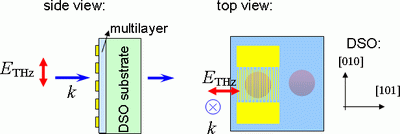
Fig. 2.
The sample geometry for investigation under bias electric field. A DC field is applied to the interdigited electrodes. The THz beam hits the sample from the top (k-direction). The electrodes are oriented perpendicular to the THz beam polarization (ETHz) and the electrode structure is thus practically transparent for the THz radiation.
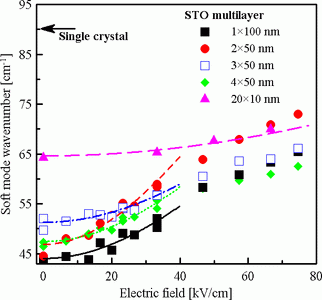
Fig. 3.
Soft mode frequency in various strained STO multilayers. For comparison, the soft mode frequency of a single SrTiO3 is marked by an arrow.
Ferroelectrics with layered Aurivillius structure
Strontium bismuth tantalate (SrBi2Ta2O9, SBT) crystallizes in the so-called layered Aurivillius structure and the ferroelectricity of this material was discovered at early 1960s. Currently this material is frequently used for producing non-volatile ferroelectric memories for its excellent polarization fatigue behaviour.
We have shown that the ferroelectric phase transition is described by a coupling of the soft phonon mode to a relaxation process below phonon frequenices. The critical slowing down of this relaxation is responsible for the dielectric anomaly near the ferroelectric transition indicating its predominantly order-disorder character. [28–30]
Microwave ceramics
Recent progress in microwave telecommunications asks for good quality ceramic dielectric resonators. The important characteristics required for these devices are high dielectric constant (in view of the size reduction), low dielectric losses (imaginary part of the permittivity) and a low temperature coefficient of resonant frequency. Ceramic technology allows preparing relatively cheap materials with defined properties for industrial applications. It appears that, despite of high permittivity, ferroelectrics are not good candidates for microwave resonators because of high losses and strong temperature variation of the permittivity. Materials related to ferroelectrics in the sense of a high ionic polarizability of the lattice but with small anharmonicity (to prevent the temperature instability) are then sought for. The permittivity of such materials ranges typically between 20 and 100 and the crucial task in the technology of elaboration of the ceramic specimens is the increase of their quality factor Q = ε′/ε″ in the whole microwave range.
The preparation method of the ceramic samples has a strong influence on the losses in the microwave region, while the dielectric constant is almost insensitive to it. Dielectric losses in microwave materials consist in an intrinsic contribution, which accounts for losses of ideal crystalline material, and in an extrinsic contribution caused by lattice defects, existence of a second phase etc. Extrinsic losses in them microwave range depend on the material preparation method and can vary by several orders of magnitude between samples of the same chemical composition but with different amount of defects. A promissing approach of evaluation of the extrinsic losses consist in the determination of higher frequency dielectric response including the THz and far-infrared range. As the intrinsic behaviour of the imaginary part of the dielectric constant is proportional to the frequency below the lowest-frequency phonon mode, TDTTS appears to be a powerful method for direct experimental estimation of the intrinsic losses in the microwave range by extrapolating the data from the sub-mm range. Many defects such as porosity, grain boundaries, microcracks, etc. can modify the simple linear behaviour of the losses versus frequency and can then lead to their increase in the microwave range. The presence of a second phase may even cause additional loss peaks in the sub-mm region. [2–11]
Photonic structures based on ferroelectric materials
Ferroelectric materials can be employed as active materials for tunable applications. In particular, they can be used for a design of narrow-band filters based on photonic crystals.
The investigated tunable filters consisted of a ferroelectric defect enclosed in a photonic crystal [31, 32]. For example, we used a SrTiO3 crystal which exhibits a strong temperature dependence of dielectric permittivity: the permittivity changes by a factor of 7 when cooled from room temperature down to 75 K. Due to this pronounced temperature dependence we were able to construct a photonic crystal filter with tunability reaching 60 %. The scheme of the filter, its tuning curve and representative transmission spectra are shown in Fig. 4. It should be stressed out that the filter is all-solid and is thus only weakly susceptible to mechanical damage.

Fig. 4. (a) Structure of the investigated tunable photonic-crystal-based filter. The photography at the bottom shows the stack of the alternating layers of quartz and CeO2 ceramics. (b) Tuning curve of the photonic crystal filter. Relative tunability reaching 60 % has been achieved. (c) Transmittance spectra of the photonic crystal filter measured at 115, 180 and 290 K.
Related publications
| [1] | E. Buixaderas, I. Gregora, S. Kamba, P. Kužel, and I. Reaney, Phonon anomalies in Pb1−xLaxZr0.9Ti0.1O3 ceramics, Appl. Phys. Lett. 94, 052903 (2009).  |
|---|---|
| [2] | S. Kamba, H. Wang, M. Berta, F. Kadlec, J. Petzelt, D. Zhou, and X. Yao, Correlation between infrared, THz and microwave dielectric properties of vanadium doped antiferroelectric BiNbO4, J. Europ. Ceram. Soc. 26, 2861 (2006).  |
| [3] | H. Wang, S. Kamba, M. Zhang, X. Yao, S. Denisov, F. Kadlec, and Jan Petzelt, Microwave and infrared dielectric response of monoclinic bismuth zinc niobate based pyrochlore ceramics with ion substitution in A site, J. Appl. Phys. 100, 034109 (2006).  |
| [4] | H. Wang, S. Kamba, H. Du, M. Zhang, C.-T. Chia, S. Veljko, S. Denisov, F. Kadlec, J. Petzelt, and X. Yao, Microwave dielectric relaxation in cubic bismuth based pyrochlores containing titanium, J. Appl. Phys. 100, 014105 (2006).  |
| [5] | A. Pashkin, S. Kamba, M. Berta, J. Petzelt, G. D. C. C. de Györgyfalva, H. Zheng, H. Bagshaw, and I. M. Reaney, High frequency dielectric properties of CaTiO3-based microwave ceramics, J. Phys. D: Appl. Phys. 38, 741 (2005).  |
| [6] | A. Pashkin, P. Kužel, J. Petzelt, B. Gorshunov, and M. Dressel, Time-resolved and backward-wave oscillator submillimetre spectroscopy of some ferroelectric ceramics and thin films, Ferroelectrics 272, 2211 (2002).  |
| [7] | H.-F. Cheng, Y.-C. Chen, H.-L. Liu, L.-G. Hwa, I-N. Lin, P. Kužel, and J. Petzelt, Terahertz and infrared spectroscopic study on dielectric properties of Bi2(Zn1/3Nb2/3)2O7 for microwave application, Ferroelectrics 272, 2247 (2002).  |
| [8] | A. Pashkin, E. Buixaderas, P. Kužel, Mei-Hui Liang, Chen-Ti Hu, and I-Nan Lin, THz transmission spectroscopy applied to dielectrics and microwave ceramics, Ferroelectrics 254, 113 (2001).  |
| [9] | Y.-C. Chen, H.-F. Cheng, Y.-M. Tsau, P. Kužel, J. Petzelt, and I-N. Lin, Synthesis and properties of dielectric Bi2(Zn1/3Nb2/3)2O7 thin films, J. European Ceram. Soc. 21, 2731 (2001).  |
| [10] | H.-F. Cheng, Y.-C. Chen, Y.-M. Tsau, P. Kužel, J. Petzelt, Y.-H. Zhu, and I-N. Lin, Dielectric properties of Bi2(Zn1/3Nb2/3)2O7 electroceramics and thin films, J. Europ. Ceram. Soc. 21, 1605 (2001).  |
| [11] | S. Kamba, J. Petzelt, E. Buixaderas, D. Haubrich, P. Vaněk, P. Kužel, I. N. Jawahar and M. T. Sebastian, and P. Mohanan, High frequency dielectric properties of A5B4O15 microwave ceramics, J. Appl. Phys. 89, 3900 (2001).  |
| [12] | S. Glinšek, D. Nuzhnyy, J. Petzelt, B. Malič, S. Kamba, V. Bovtun, M. Kempa, V. Skoromets, P. Kužel, I. Gregora, and M. Kosec, Lattice dynamics and broad-band dielectric properties of the KTaO3 ceramics, J. Appl. Phys. 111, 104101 (2012).  |
| [13] | V. Skoromets, S. Glinšek, V. Bovtun, M. Kempa, J. Petzelt, S. Kamba, B. Malič, M. Kosec, and P. Kužel, Ferroelectric phase transition in polycrystalline KTaO3 thin film revealed by terahertz spectroscopy, Appl. Phys. Lett. 99, 052908 (2011).  |
| [14] | D. Nuzhnyy, J. Petzelt, S. Kamba, P. Kužel, C. Kadlec, V. Bovtun, M. Kempa, J. Schubert, C. M. Brooks, and D. G. Schlom, Soft mode behavior in SrTiO3/DyScO3 thin films: Evidence of ferroelectric and antiferrodistortive phase transitions, Appl. Phys. Lett. 95, 232902 (2009).  |
| [15] | T. Ostapchuk, J. Petzelt, J. Hlinka, V. Bovtun, P. Kužel, I. Ponomareva, S. Lisenkov, L. Bellaiche, A. Tkach, and P. Vilarinho, Broad-band dielectric spectroscopy and ferroelectric soft-mode response in the Ba0.6Sr0.4TiO3 solid solution, J. Phys.: Cond. Matter. 21, 474215 (2009).  |
| [16] | J. Hlinka, T. Ostapchuk, D. Nuzhnyy, J. Petzelt, P. Kužel, C. Kadlec, P. Vaněk, I. Ponomareva, and L. Bellaiche, Coexistence of the phonon and relaxation soft modes in the terahertz dielectric response of tetragonal BaTiO3, Phys. Rev. Lett. 101, 167402 (2008).  |
| [17] | T. Ostapchuk, J. Petzelt, P. Kužel, S. Veljko, A. Tkach, P. Vilarinho, I. Ponomareva, L. Bellaiche, E. Smirnova, V. Lemanov, A. Sotnikov, and M. Weihnacht, Infrared and THz soft-mode spectroscopy of (Ba,Sr)TiO3 ceramics, Ferroelectrics 367, 139 (2008).  |
| [18] | J. Petzelt, T. Ostapchuk, I. Gregora, P. Kužel, J. Liu, and Z. Shen, Infrared and Raman studies of the dead grain-boundary layers in SrTiO3 fine-grain ceramics, J. Phys.: Cond. Matter 19, 196222 (2007).  |
| [19] | J. Petzelt, P. Kužel, I. Rychetský, A. Pashkin, T. Ostapchuk, Dielectric response of soft modes in ferroelectric thin films, Ferroelectrics 288, 169 (2003).  |
| [20] | A. Pashkin, P. Samoukhina, T. Ostapchuk, P. Kužel, P. Vilarinho, and J. Petzelt, Submillimeter and far infrared dielectric response of Bi-doped SrTiO3 ceramics, Ferroelectrics 294, 133 (2003).  |
| [21] | V. Skoromets, C. Kadlec, P. Kužel, S. Kamba, and J. Schubert, Electric field tuning of hard polar phonons in strained SrTiO3 films, J. Appl. Phys. 107, 124116 (2010).  |
| [22] | C. Kadlec, V. Skoromets, F. Kadlec, H. Němec, J. Hlinka, J. Schubert, G. Panaitov, and P. Kužel, Temperature and electric field tuning of the ferroelectric soft mode in a strained SrTiO3/DyScO3 heterostructure, Phys. Rev. B 80, 174116 (2009).  |
| [23] | C. Kadlec, F. Kadlec, H. Němec, P. Kužel, J. Schubert, and G. Panaitov, High tunability of the soft mode in strained SrTiO3/DyScO3 multilayers, J. Phys.:Cond. Matter. 21, 115902 (2009).  |
| [24] | P. Kužel, F. Kadlec, H. Němec, R. Ott, E. Hollmann, and N. Klein, Dielectric tunability of SrTiO3 thin films in the terahertz range, Appl. Phys. Lett 88, 102901 (2006).  |
| [25] | P. Kužel, F. Kadlec, J. Petzelt, J. Schubert and G. Panaitov, Highly tunable SrTiO3/DyScO3 heterostructures for applications in the terahertz range, Appl. Phys. Lett. 91, 232911 (2007).  |
| [26] | P. Kužel and F. Kadlec, Tunable structures and modulators for THz light, Comptes Rendus Physique 9, 197 (2008).  |
| [27] | P. Kužel, C. Kadlec, F. Kadlec, J. Schubert, and G. Panaitov, Field-induced soft mode hardening in SrTiO3/DyScO3 multilayers, Appl. Phys. Lett. 93, 052910 (2008).  |
| [28] | D. Nuzhnyy, S. Kamba, P. Kužel, S. Veljko, V. Bovtun, M. Savinov, J. Petzelt, H. Amorín, M. E. V. Costa, A. L. Kholkin, Ph. Boullay, and M. Adamczyk, Dynamics of the phase transitions in Bi-layered ferroelectrics with Aurivillius structure: Dielectric response in the terahertz spectral range, Phys. Rev. B 74, 134105 (2006).  |
| [29] | F. Kadlec, S. Kamba, P. Kužel, C. Kadlec, J. Kroupa, and J. Petzelt, High-temperature phase transitions in SrBi2Ta2O9 film: a study by THz spectroscopy, J. Phys.: Cond. Matter 16, 6763 (2004).  |
| [30] | M. Kempa, P Kužel, S. Kamba, P. Samoukhina, J. Petzelt, A. Garg, and Z. H. Barber, The ferroelectric soft mode and central mode in SrBi2Ta2O9 films, J. Phys.: Cond. Matter. 15, 8095 (2003).  |
| [31] | H. Němec, P. Kužel, L. Duvillaret, A. Pashkin, M. Dressel, and M. T. Sebastian, Highly tunable photonic crystal filter for the terahertz range, Opt. Lett. 30, 549 (2005).  |
| [32] | H. Němec, L. Duvillaret, F. Garet, P. Kužel, P. Xavier, J. Richard, and D. Rauly, Thermally tunable filter for terahertz range based on a one-dimensional photonic crystal with a defect, J. Appl. Phys. 96, 4072 (2004).  |
| last change December 13, 2018 | (home page) |
|---|
